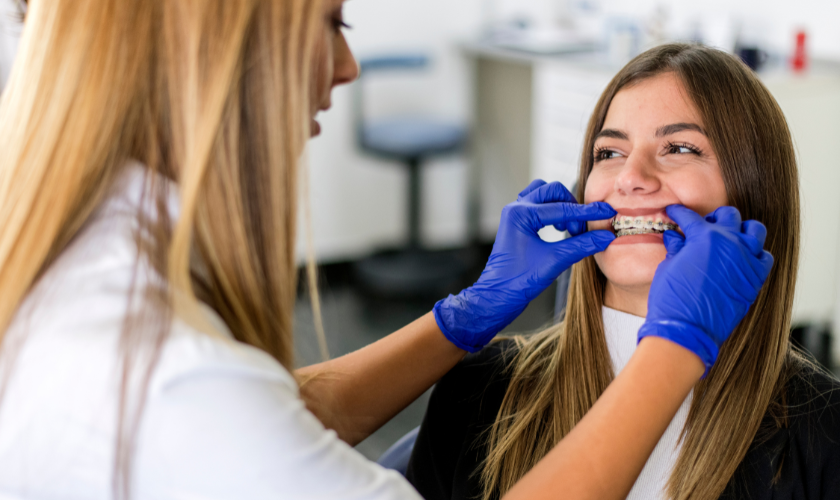817-803-8090
Types of Emergencies in Orthodontics & How To Identify Them

Types of Emergencies in Orthodontics & How To Identify Them
Introduction to Orthodontic Emergencies
Orthodontic emergencies are relatively rare, but they can happen. It’s important to be aware of the different types of orthodontic emergencies and how to identify them so that you can seek treatment as soon as possible.
The most common type of orthodontic emergency is a loose bracket or band. This can happen if you eat hard foods, chew on gum, or play sports without a mouthguard. If you notice a loose bracket or band, gently remove it and bring it with you to your next orthodontist appointment.
Another common type of emergency is a broken wire. This can happen if the wire becomes caught on something or if you try to adjust it yourself. If you have a broken wire, use tweezers to remove it and cover the end with wax before bringing it to your next appointment.
Less common emergencies include tooth displacement and jaw pain. These usually require more immediate attention from an orthodontist and may need to be treated in the office.
If you have any questions about what constitutes an emergency or how to handle one, be sure to ask your orthodontist during your next appointment.
Different Types of Orthodontic Emergencies
There are different types of orthodontic emergencies, and it is important to know how to identify them. Here are some of the most common orthodontic emergencies:
1. Loose Braces:
If your braces become loose, it is important to see an orthodontist as soon as possible. Loose braces can cause discomfort and can also damage your teeth if they are not fixed.
2. Broken brackets:
If a bracket on your braces breaks, it is important to see an orthodontist as soon as possible. Broken brackets can cause discomfort and can also damage your teeth if they are not fixed.
3. Loose wires:
If a wire on your braces becomes loose, it is important to see an orthodontist as soon as possible. Loose wires can cause discomfort and can also damage your teeth if they are not fixed.
4. Sore spots:
If you have sore spots on your gums or cheeks, it is important to see an orthodontist as soon as possible. Sore spots can be caused by braces rubbing against your gums or cheeks, and they can also be a sign of infection.
5. Swelling:
If you have swelling in your mouth or face, it is important to see an orthodontist as soon as possible. Swelling can be a sign of infection or other serious medical condition
Identifying the Symptoms of an Orthodontic Emergency
There are a few orthodontic emergencies that can pop up unexpectedly, and it’s important to be able to identify them so you can get the treatment you need right away. Here are some of the most common orthodontic emergencies and their symptoms:
-Broken brackets or bands:
This is one of the most common orthodontic emergencies. The symptoms are usually pretty straightforward – you’ll see that a bracket or band is no longer attached to the tooth. In some cases, the bracket or band may still be attached to the wire, which can cause discomfort. If this happens, try to gently remove the broken piece with a pair of tweezers. If you can’t remove it yourself, don’t try to force it – this could cause more damage. Call your orthodontist right away so they can remove it for you.
-Loose wires:
Another common orthodontic emergency is a loose wire. This can happen if a wire pops out of its bracket or if it becomes bent or twisted. If a wire is poking you, try to gently push it back into place with a cotton swab or eraser head. If you can’t get it back into place, cover the end of the wire with wax or tape so it doesn’t poke you. Again, call your orthodontist right away so they can fix the problem.
Treatment for Orthodontic Emergencies
There are a few different types of orthodontic emergencies that can occur, and it’s important to know how to identify them so you can seek treatment as soon as possible. Some common orthodontic emergencies include:
• Broken brackets or bands:
This can happen if you eat something hard or sticky, or if you accidentally hit your braces. If a bracket or band comes loose, be sure to save it so your orthodontist can reattach it. In the meantime, use wax to cover any sharp edges.
• Loose wires:
Wires can come loose if they’re not tightened properly, or if you eat something hard or sticky. If a wire comes loose, try to push it back into place with a cotton swab. If that doesn’t work, use wax to cover the end of the wire.
• Soreness:
Soreness is normal after you first get braces, but it should go away after a few days. If the soreness persists or gets worse, call your orthodontist.
If you experience any of these orthodontic emergencies, call your orthodontist right away for advice on how to proceed.
Preventing Orthodontic Emergencies
Orthodontic emergencies can be painful and disruptive, but they are often avoidable with proper care. Here are some tips to prevent orthodontic emergencies:
-Wear your mouthguard when playing sports or engaging in other activities where there is a risk of injury to the face.
-Be careful when eating hard or sticky foods, as they can damage brackets and wires. Cut up hard foods into small pieces and avoid sticky sweets altogether.
-Brush and floss your teeth regularly to avoid gum disease and tooth decay, which can lead to emergency situations.
-See your orthodontist for regular checkups and adjustments, as this will help ensure that your treatment is progressing as planned and that any potential problems are caught early.
Conclusion
Orthodontic emergencies can happen at any time, and it is important to be aware of the different types and how to recognize them. By understanding the signs of an orthodontic emergency, you can take immediate action to get prompt treatment and prevent further damage. Remember that when in doubt, contact your orthodontist as soon as possible for professional advice on what steps need to be taken next.
FAQ’s
1. What are the different types of emergencies that can occur during orthodontic treatment?
1. The different types of emergencies that can occur during orthodontic treatment include broken brackets, loose wires, and protruding wires.
2. How can I identify if I am experiencing an emergency?
2. You can identify an emergency by the pain you are experiencing. If the pain is severe, you should seek medical attention immediately.
3. What should I do if I am experiencing an emergency?
3. If you are experiencing an emergency, you should contact your orthodontist or dentist as soon as possible so that they can assess the situation and provide you with appropriate treatment.





